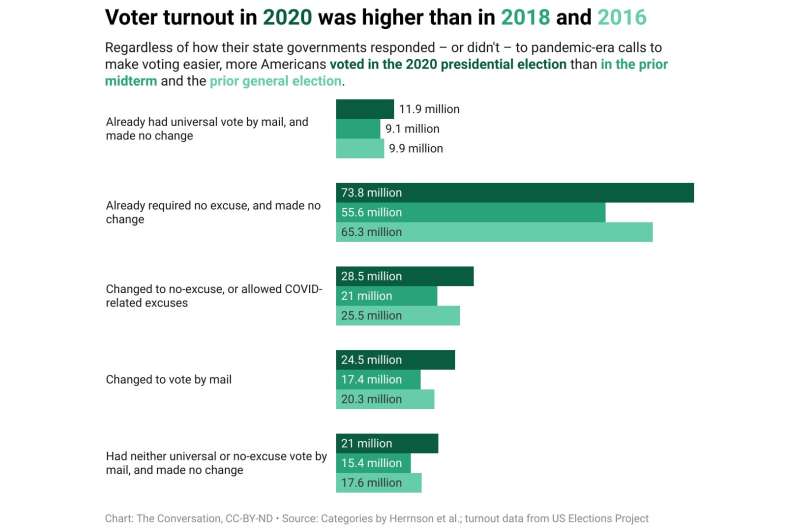Most voters skipped 'in person on Election Day' when offered a choice of how and when to vote

When the COVID-19 pandemic hit in early 2020, state lawmakers, election administrators and others realized they had to move quickly. A presidential election was coming in just a few months, along with elections for every seat in the U.S. House of Representatives, one-third of the U.S. Senate, and all sorts of state and local positions. Primary season was already underway. And nobody was sure how safe it would be to vote in person at polling places.
Ultimately, the collective efforts of these public servants delivered an election with a . cast a ballot. This happened even as the .
A key factor in that success was adaptability—of elected officials, election administrators and voters themselves. Officials knew they had to make changes so people could vote safely, and they had to find ways to protect the integrity of the process.
Partisan politics played a role, too.
Many Democrats , such as early in-person voting and voting by mail. Many Republicans . President Donald Trump especially objected to mail voting, tweeting, ", ballots will be forged & even illegally printed out & fraudulently signed." Numerous GOP leaders followed his lead, though no fraud sufficient to change the election results .
Research my colleagues and I have conducted has found that when it came down to the people's choice, there was a clear outcome: at a polling place on Election Day are becoming more common, and more popular. Of the in the 2020 election according to the Federal Election Commission, —64% of them—were cast by mail or by early in-person voting. A for the 2022 midterms.
Options for voting
Even before the pandemic, most states offered one or more of what are sometimes called "convenience voting" options—alternatives to showing up in person on the in November.
lets someone come to a government office, school, shopping mall or other designated site and cast a ballot in the days or weeks before Election Day.
With , election officials use the U.S. mail to send ballots to voters, who fill out their ballots at home and either mail them back or drop them off at a designated location.
Before 2020, required a voter to provide a specific reason, such as age or disability, to receive a ballot by mail. Twenty-nine states and the District of Columbia required no excuse. And the five states where elections were conducted by mail automatically sent a ballot to each registered voter.
Before the 2020 election and afterward, Trump and many of his allies questioned the integrity of mail voting. They filed court cases, called for recounts, and even conducted a partisan review of votes cast in Arizona, which was widely discredited. , little evidence of fraud in mail voting—or in any other type of voting—was uncovered. Even U.S. Attorney General William Barr, a Trump appointee, conceded there was insufficient evidence to cast doubt on the election outcome.
Instead of injecting fraud, mail ballots have made it easier for people to cast a ballot and play a role in charting the course of our nation's future.
States made changes
Data my colleagues and I collected from states' websites and other sources shows in 2020. The result was that registered voters in nine states and the District of Columbia were automatically mailed a ballot. In 36 states, voters could successfully apply for a mail ballot without providing an excuse or listing COVID-19 as an excuse.
Voters in the remaining five states qualified for a mail ballot only if their application included a sanctioned excuse, such as out-of-town travel on Election Day, that did not include concerns about contracting COVID-19.
Our analysis found that partisanship played a role in which voters had which options. States with Democratic governors and Democratic-controlled legislatures were the most likely to adopt mail voting, followed by states where party control was divided. Republican-controlled states were the least likely to make changes. Indiana and three of the four conservative Southern states that continued to require a non-COVID excuse for a mail ballot were under Republican control. Louisiana, the other state maintaining an excuse requirement, had a Democratic governor and a GOP-controlled legislature.
How Americans voted
how people voted, we found.
than showing up on Election Day 2020.
Voters' familiarity with the options affected their choices. In the 25 states that had a history of no-excuse mail voting (excluding the five that switched to automatically mailing registered voters a ballot), voters were to use a mail ballot in 2020 than voters first given a no-excuse option that year.
And voters in these same 25 no-excuse states were almost 27 points more likely to vote by mail than voters in the five states that continued to require an excuse.
We also found that partisanship played a role in what methods people chose to vote. Democratic voters were to vote by mail than independents, and a whopping 26 points more likely to vote by mail than Republicans. GOP voters vastly preferred going to the polls on Election Day, and more of them voted early in-person than by mail.
In addition to selecting a president, the 2020 election made clear that many Americans—all across the nation and of all political stripes—prefer to cast their ballots by methods other than showing up on Election Day itself.
Provided by The Conversation
This article is republished from under a Creative Commons license. Read the .![]()



















